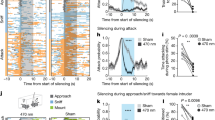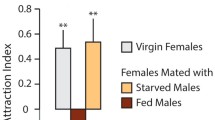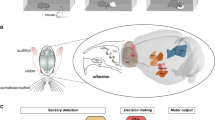Abstract
Odors detected by the vomeronasal organ or the main olfactory epithelium (MOE) trigger social behaviors in many animals. It is unknown whether MOE neurons detect cues that initiate mating or aggression. We demonstrate that mice lacking functional CNGA2 (cyclic nucleotide–gated channel α2), which is required for odor-evoked MOE signaling, fail to mate or fight, suggesting a broad and essential role for the MOE in regulating these behaviors.



Similar content being viewed by others
References
Belluscio, L., Gold, G.H., Nemes, A. & Axel, R. Neuron 20, 69–81 (1998).
Restrepo, D., Arellano, J., Oliva, A.M., Schaefer, M.L. & Lin, W. Horm. Behav. 46, 247–256 (2004).
Leypold, B. et al. Proc. Natl. Acad. Sci. USA 99, 6376–6381 (2002).
Stowers, L., Holy, T.E., Meister, M., Dulac, C. & Koentges, G. Science 295, 1493–1500 (2002).
Del Punta, K. et al. Nature 419, 70–74 (2002).
Wong, S.T. et al. Neuron 27, 487–497 (2000).
Berghard, A., Buck, L.B. & Liman, E.R. Proc. Natl. Acad. Sci. USA 93, 2365–2369 (1996).
Brunet, L.J., Gold, G.H. & Ngai, J. Neuron 17, 681–693 (1996).
Miczek, K.A., Maxson, S.C., Fish, E.W. & Faccidomo, S. Behav. Brain Res. 125, 167–181 (2001).
Pankevich, D.E., Baum, M.J. & Cherry, J.A. J. Neurosci. 24, 9451–9457 (2004).
Lin, Y., Zhang, S.Z., Block, E. & Katz, L.C. Nature 434, 470–477 (2005).
Luo, M., Fee, M.S. & Katz, L.C. Science 299, 1196–1201 (2003).
Sam, M. et al. Nature 412, 142 (2001).
Kingston, P.A., Zufall, F. & Barnstable, C.J. Synapse 32, 1–12 (1999).
Devor, M. & Murphy, M.R. Behav. Biol. 9, 31–42 (1973).
Acknowledgements
The authors thank D. Anderson, R. Axel, H. Baier, U. Heberlein, L. Jan, D. Julius and members of the Shah lab for comments on the manuscript. We thank J. Ngai for providing us with Cnga2 mutant females and J. Wong for administrative support. This work was supported by a grant from the National Institutes of Health (R01 NS049488), a Career Award in the Biomedical Sciences from the Burroughs Wellcome Fund, the Sandler Family Supporting Foundation and funds from Research Evaluation and Allocation Committee (REAC) at University of California, San Francisco (N.M.S.). N.M.S. is a McKnight Scholar and a Sloan Fellow.
Author information
Authors and Affiliations
Corresponding author
Ethics declarations
Competing interests
The authors declare no competing financial interests.
Supplementary information
Supplementary Fig. 1
Cnga2 mutant males groom conspecifics in a manner similar to WT males. (PDF 167 kb)
Rights and permissions
About this article
Cite this article
Mandiyan, V., Coats, J. & Shah, N. Deficits in sexual and aggressive behaviors in Cnga2 mutant mice. Nat Neurosci 8, 1660–1662 (2005). https://doi.org/10.1038/nn1589
Received:
Accepted:
Published:
Issue Date:
DOI: https://doi.org/10.1038/nn1589
- Springer Nature America, Inc.
This article is cited by
-
Sex steroid hormone synthesis, metabolism, and the effects on the mammalian olfactory system
Cell and Tissue Research (2023)
-
Hormonal, Genetic, Immunological: An Array of Mechanisms but How Do They Interact, If at All?
Archives of Sexual Behavior (2023)
-
Neural circuit control of innate behaviors
Science China Life Sciences (2022)
-
Coding of pheromones by vomeronasal receptors
Cell and Tissue Research (2021)
-
Neural circuit mechanisms that govern inter-male attack in mice
Cellular and Molecular Life Sciences (2021)





